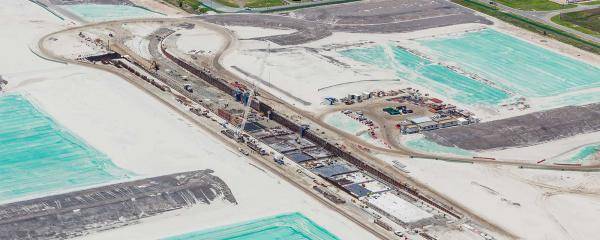Early Planning
Brisbane’s new runway is the completion of long-term planning which commenced in the 1970s for Brisbane Airport. Ever since planning began a wide-spaced parallel runway system in a north-south alignment has been a key feature of the ultimate development vision.
The airport opened in its current location in 1988 with the existing main runway, the smaller cross runway, the Domestic Terminal and the new air traffic control tower in place. During this initial construction phase in the 1980s space was reserved to the west of the then new airport for a parallel runway to be built in the future when it was needed.
The parallel system remained the central planning feature for future expansion in the period up to Brisbane Airport Corporation’s (BAC) purchase of Brisbane Airport in 1997. BAC retained this planning vision, with some minor improvements tweaks in its first two Master Plans 1998 and 2003 respectively.
The final design of Brisbane's new runway is a nod to the legacy of the early planners in selecting a site and airfield layout that remains the best solution half a century on.
Approvals
Prior to proceeding to construction of the new runway, approvals from all three levels of government were obtained, though the primary environment and planning assessment for major developments at Brisbane Airport is regulated by the Australian Government.
The new runway proposal was subject to two major pieces of Australian Government legislation – the Airports Act, 1996 (Airports Act) and the Environment Protection and Biodiversity Conservation Act, 1999 (EPBC Act).
To fulfil the requirements of both Acts, Brisbane Airport Corporation (BAC) developed a combined document, a Major Development Plan (MDP) under the Airports Act and an Environmental Impact Statement (EIS) under the EPBC Act for presentation to the public.
The EIS/MDP looked at both the construction and operational impacts of a new runway. The findings were shared with the public for their comment prior to the Australian Government’s consideration for approval which was received in September 2007.
Review the final EIS/MDP documents below.
Volume A – Background and Need
Volume A of the EIS/MDP contains an overview of the Brisbane's New Runway project.
It looks at the history of Brisbane Airport and the circumstances that led BAC to put forward the proposal to build a new runway, including the options and alternatives that were considered.
In this Volume, the new runway is described, including its layout and construction, method and timing. In addition, the methods by which BAC reached and informed the community and other stakeholders about the project in the lead up to and during the Public Comment Period are also outlined.
Download chapters from Volume A – Background and Need
Volume B - Airport and Surrounds
This volume of the EIS/MDP reports on “ground level” aspects of the runway project, assessing impacts on airport land, its fringes and surrounding areas, as well as socio-economic impacts. The volume concludes with a framework for the Environmental Management Plan (EMP) that summarises the best practice management strategies, measures and monitoring requirements that will be applied to the project.
The areas covered in this volume include:
- Airport land
- Areas immediately to the west comprising open space along Kedron Brook Floodway, the southern extent of the Boondall Wetlands and parts of the suburbs of Nudgee Beach, Banyo and Northgate
- Areas immediately to the north comprising Bramble Bay, which is part of the Moreton Bay Marine Park
- The northern bank of the Brisbane River that is adjacent to and east of the Airport including industrial and residential land, as well as the Luggage Point Waste Water Treatment Plant
- The southern boundary of the Airport bounded by the Gateway Motorway, the Australia TradeCoast region and various suburbs that contain a mix of residential, commercial and industrial land uses
- Major infrastructure projects in the local region such as the Gateway Upgrade Project.
Download chapters from Volume B – Airport and Surrounds
Volume C - Middle Banks, Moreton Bay
This volume of the EIS/MDP reports on investigations linked to the dredging of 15 million cubic metres of sand from Middle Banks in Moreton Bay.
Download chapters from Volume C – Middle Banks, Moreton Bay
Volume D - Airspace
This volume of the EIS/MDP reports on “Airspace“ aspects of the runway project. Assessing changes to the airspace architecture to accommodate the new runway, including changes to flight paths and community exposure to aircraft noise, as well as the potential impacts of aircraft emissions on the local and regional air quality.
The safe, efficient and environmentally responsible movement of aircraft in and out of Brisbane Airport is a fundamental objective of the operation of the airport. Flight paths, air traffic management and the operating modes for the airport runway system play an integral part in fulfilling this objective.
Brisbane's new runway will necessitate changes to the current arrangements at Brisbane Airport. In developing the new system of operation, community expectations for the best possible outcomes for safety, efficiency and the environmental effects were taken into account.
The areas that are covered in Volume D of the EIS/MDP include:
- Airspace Architecture. This section provides a description of the current airspace with respect to air traffic management and the changes to the airspace and flight paths required to accommodate the new runway. This section also includes options for new flight paths.
- Noise Modelling Methodology and Noise Assessment. These sections explain how noise was modelled and provide a comprehensive assessment of current noise exposure and the changes to aircraft noise associated with increased activity.
Download chapters from Volume D – Airspace
Community Engagement & Communications Report
Brisbane's New Parallel Runway Communications Strategy was delivered in multiple phases, in conjunction with the process of the 2009 & 2014 Brisbane Airport Master Plans, as well as the New Runway construction works (2012-2020).
The Community Engagement and Communications Report provides an overview of the community engagement activity and supporting communications programs and information campaigns undertaken during these timeframes.

